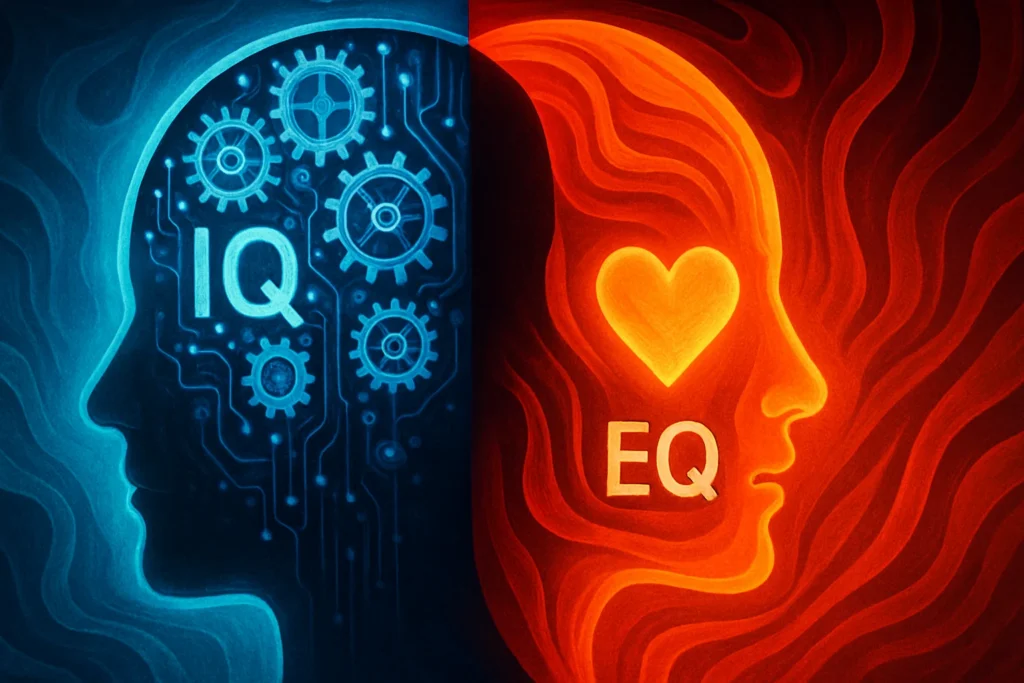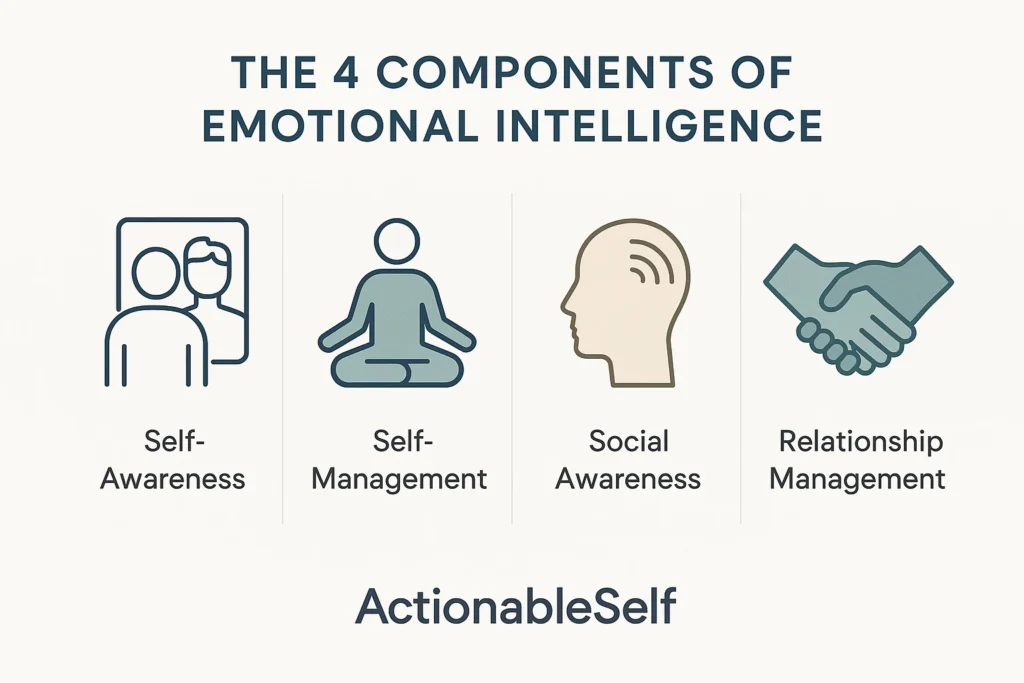
You’ve likely heard that Emotional Intelligence (EQ) is a critical factor for success in life and work. Some experts even argue it’s more important than traditional intelligence (IQ). But what exactly is it?
EQ isn’t one single skill. It’s not just about “being nice” or “empathetic.” It’s a complex and powerful set of abilities that work together to help us navigate our social world with greater success and fulfillment.
The most practical and widely accepted way to understand EQ is through the four-component model popularized by psychologist and author Daniel Goleman. This framework breaks down emotional intelligence into four distinct, learnable skills. Think of them as two pairs: the first two are about you, and the last two are about how you interact with others.
This guide will provide a clear, in-depth definition for each of the four core components of emotional intelligence. We’ll explore what each one looks like in the real world and give you actionable first steps to start developing them today.

Part 1: Personal Competence (Mastering Yourself)
The first two components are the foundation of all emotional intelligence. They are about how you perceive and manage yourself. Without a strong foundation in personal competence, it’s nearly impossible to be effective in your interactions with others.
1. Self-Awareness: The Cornerstone of EQ

- What it is: Self-awareness is the ability to accurately recognize your own emotions as they happen and to understand your general tendencies. It’s the skill of seeing yourself clearly and objectively. This includes understanding your strengths, weaknesses, values, and the impact you have on other people. It is, without a doubt, the most important component of EQ.
- Why it’s so important: You cannot manage an emotion you don’t recognize. You cannot understand someone else’s feelings if you don’t understand your own. Self-awareness is the starting point for all growth. It allows you to make conscious choices based on your values, rather than reacting blindly to your feelings. People with high self-awareness are more confident, make better decisions, and have a clearer sense of purpose.
What Self-Awareness Looks Like in Practice
- At Work:
- Low Self-Awareness: A project deadline is missed, and you immediately blame your team for being slow. You don’t recognize that your own unclear instructions and procrastination were major factors.
- High Self-Awareness: You recognize your feeling of disappointment. But you can also reflect: “I was anxious about this project, so I avoided asking for help. My procrastination contributed to this delay. I need to own that.”
- At Home:
- Low Self-Awareness: You snap at your partner for a minor issue, like leaving a dish in the sink. You don’t realize you’re actually irritable from a stressful day at work.
- High Self-Awareness: You feel the irritation rising and can think, “I’m feeling tense because of that difficult meeting. It has nothing to do with this dish. I need a moment to decompress.”
How to Start Developing Your Self-Awareness
- Keep a “Five-Minute Journal”: At the end of each day, take just five minutes to write down the answer to these questions: “What was the high point of my day?”, “What was the low point?”, and “When did I feel the strongest emotion, and what triggered it?” This simple habit trains you to pay attention to your inner world.
- Practice “Emotional Check-ins”: Set a random alarm on your phone for three times during the day. When it goes off, pause for 30 seconds. Ask yourself: “What am I feeling right now?” Try to name the specific emotion (e.g., not just “bad,” but “frustrated,” “disappointed,” or “tired”).
- Ask for Loving Feedback: Choose one trusted friend or family member. Ask them this powerful question: “What is one thing you think I do well, and one thing you think I could improve on?” The goal is not to defend yourself, but to simply listen and understand their perspective.
Self-awareness is so crucial, we’ve dedicated an entire guide to it. Explore our Journey to Self-Awareness & Self-Esteem.
2. Self-Management: Thinking Before You Act

- What it is: Self-management is what you do with your awareness. It’s the ability to control or redirect your disruptive impulses and moods. It’s about managing your emotional state in a healthy, productive way so that your emotions serve you, rather than control you.
- Why it’s so important: Life is filled with stressful situations and unexpected challenges. Self-management is what allows you to stay calm under pressure, to think clearly when you’re frustrated, and to bounce back from setbacks. It’s the foundation of trustworthiness, integrity, and adaptability. People with strong self-management are seen as reliable and level-headed.
What Self-Management Looks Like in Practice
- At Work:
- Low Self-Management: You receive a critical email from your boss and immediately fire back an angry, defensive response that you later regret.
- High Self-Management: You receive the same email. You feel the anger rise, but you decide to draft the response, save it, and review it in an hour after you’ve calmed down.
- At Home:
- Low Self-Management: You get cut off in traffic and spend the next ten minutes yelling and honking your horn, ruining your mood and stressing out your passengers.
- High Self-Management: You get cut off, take a deep breath, and put on a calming podcast. You recognize that the other driver’s actions are out of your control, but your reaction is within your control.
How to Start Developing Your Self-Management
- Master the Strategic Pause: When you feel a strong negative emotion, commit to a 10-second pause before you speak or act. This tiny gap is often enough for your “thinking brain” to catch up with your “emotional brain.”
- Practice Cognitive Reframing: Your interpretation of an event determines your emotional response. Practice challenging your negative thoughts. When you think, “This project is a complete disaster,” ask yourself, “Is that 100% true? What’s one small part of it that is going well? What can I learn from this?”
- Use “If-Then” Planning: For known triggers, create a simple plan. For example: “IF I start to feel overwhelmed in the team meeting, THEN I will take a sip of water and focus on my breathing for 10 seconds.” This pre-planning makes it much easier to manage your response in the moment.
Part 2: Social Competence (Interacting with Others)
The next two components are about how you apply your personal competence to your interactions with the world. This is where your EQ becomes visible to others.
3. Social Awareness (Empathy): Understanding Others

- What it is: Social awareness is the ability to accurately pick up on the emotions of other people and understand what is really going on with them. It’s the skill of reading the room and treating people with consideration. At its core, this is empathy.
- Why it’s so important: Empathy is the foundation of all effective communication and interpersonal relationships. When you can understand another person’s perspective, you can build trust, resolve conflicts, and motivate teams. It’s a crucial skill for leaders, salespeople, parents, and partners. A lack of social awareness can lead to constant misunderstandings and strained relationships.
What Social Awareness Looks Like in Practice
- At Work:
- Low Social Awareness: You launch into your agenda at the start of a meeting. You don’t notice that your team members are quiet, withdrawn, and clearly worried about recent layoff rumors.
- High Social Awareness: You read the room and notice the tension. You start the meeting by saying, “I know there’s a lot of uncertainty right now. Before we start, how is everyone feeling?”
- At Home:
- Low Social Awareness: Your partner comes home and is unusually quiet. You ignore it and start talking about your day, missing their clear non-verbal cues of sadness.
- High Social Awareness: You notice their quietness and slumped shoulders. You put down your phone and say, “You seem a little down today. Is everything okay?”
How to Start Developing Your Social Awareness
- Pay Attention to Body Language: In your next meeting, make it a game. Pay as much attention to people’s body language and tone of voice as you do to their words. What are they really saying?
- Get Curious, Not Critical: When someone acts in a way you don’t understand, try to get curious instead of judgmental. Ask yourself, “I wonder what’s going on in their world that would make them act this way?” This simple question is the start of empathy.
- Put Yourself in Their Shoes: Think of a recent disagreement you had. For five minutes, try to argue the other person’s side of the story, from their perspective, with as much conviction as you can.
4. Relationship Management: Connecting with Others

- What it is: This is where you put all the other skills together. It’s the ability to use your awareness of your own emotions and the emotions of others to build and maintain healthy, effective relationships. It’s about inspiring, influencing, and connecting with people.
- Why it’s so important: This skill turns your EQ into real-world results. It helps you be a good leader, a trusted friend, and a great teammate. People with this skill are good at handling disagreements, giving feedback, and making others feel comfortable and motivated, often because they have mastered practical techniques like active listening.
What Relationship Management Looks Like in Practice
- At Work:
- Low Relationship Management: You publicly blame an individual for a team mistake. This creates a culture of fear and destroys trust.
- High Relationship Management: You address the mistake privately and constructively. You focus on the process, not the person. You lead a “blameless post-mortem” to find a solution together.
- At Home:
- Low Relationship Management: You let small resentments build up over time. Eventually, you explode in a big argument over something trivial.
- High Relationship Management: You notice a recurring issue. You initiate a calm, respectful conversation to address it before it becomes a major problem.
How to Start Developing Your Relationship Management
- Acknowledge the Other Person’s Feelings: In a disagreement, start by showing you understand their side. Simply saying, “I can see that you’re feeling frustrated about this,” can completely change the tone of a conversation.
- Give Specific, Positive Feedback: Make it a goal to praise people more often. Be specific. “Good job” is fine, but “The way you handled that difficult client call with such patience was really impressive” is much more powerful.
- Address Problems Directly and Respectfully: Don’t avoid hard conversations. Approach them with the goal of finding a solution together, not of winning an argument. Use “I” statements, like “I feel…” instead of “You always…”
Understanding these four components is the first step. To learn how to develop each one, explore our Complete Guide to Emotional Intelligence (EQ).
How the 4 Components Work Together: A Case Study
Let’s see how these skills combine in a real-world scenario.
Imagine a manager, Sarah, whose team just missed a major project deadline.
- Self-Awareness: Sarah feels a wave of intense disappointment and anxiety. She recognizes these feelings. She also recognizes her impulse to find someone to blame.
- Self-Management: Instead of calling an immediate, angry meeting, she takes a 30-minute walk. This helps her process her emotions. She decides to approach the situation with curiosity, not anger.
- Social Awareness: In the team meeting, she observes her team’s body language. They are defensive, scared, and demotivated. She realizes that blaming them will only make things worse.
- Relationship Management: She starts the meeting by saying, “I know we’re all disappointed about the deadline. This is a team failure, and that includes me. Let’s spend this time not on blame, but on understanding what happened in our process so we can make sure it never happens again.”
By using all four components, Sarah transforms a potential disaster that could have destroyed team morale into a powerful learning opportunity that builds trust and improves future performance.
A Skillset for a Better Life
Emotional intelligence is not a fixed talent. It’s a set of four skills that you can learn and practice over time.
Think of it like learning to play an instrument.
- First, you learn the notes (Self-Awareness).
- Then, you practice playing those notes correctly (Self-Management).
- Next, you learn to listen to the other musicians in the band (Social Awareness).
- Finally, you learn to play together in harmony to create beautiful music (Relationship Management).
By understanding and consistently practicing these four core skills, you can profoundly improve your career, your relationships, and your overall happiness.
Which of these four skills do you feel is your strongest, and which one would you like to develop further? Share in the comments!


